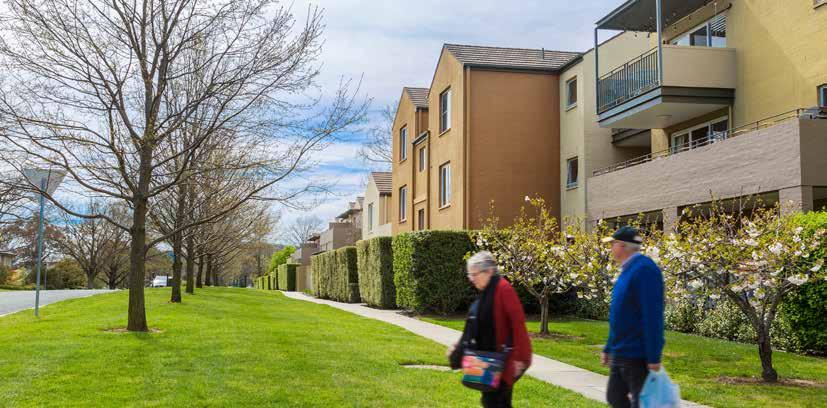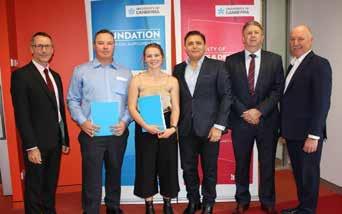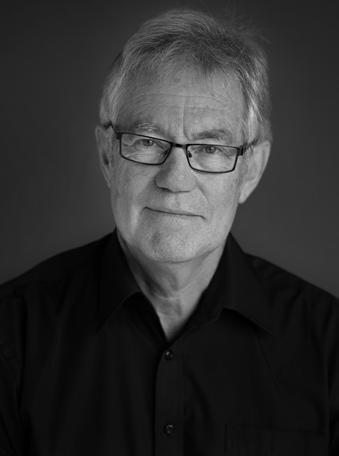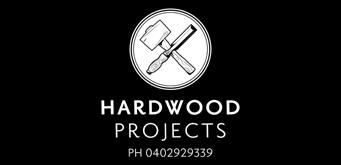
20 minute read
CHC – House with no steps
CHC partner with disability providers to deliver Kambah project
Moncrieff Project
Canberra’s leading provider of community housing, CHC, has partnered with House with No Steps and Canberra-based Care Plus Services to deliver a landmark Specialist Disability Accommodation (SDA) project in Kambah.
CHC announced the purchase of six residential sites in Richman Place in July with a plan to deliver affordable housing options, in line with the company’s mission. The original properties, constructed from bonded asbestos, were used for public housing and demolished prior to sale to CHC in early 2017.
Increasing the company’s tenancy-base to provide greater access to affordable rental accommodation was a goal at Kambah, but with a very special client in-mind.
The planned development will consist of 11 dwellings – three blocks with standalone houses, one as a standard and ancillary house, and the remaining two will be consolidated to include six small single-storey specialist disability dwellings.
CHC’s General Manager, Operations, Megan Ward said, “Early in 2017, CHC received accreditation under the National Disability Insurance Scheme (NDIS) and we quickly identified some significant challenges around connecting disability products with those that need them most.”
The main challenge was the requirement under the NDIS to deliver purpose-built products, which meant that speculatively building for the future was not an option. The NDIS requires registered providers of disability housing to understand their audience in detail and design a home to their specific needs to ensure products meet the market.
“We had the vision, the land and the internal infrastructure to deliver specialist disability housing but we had to overcome hurdles around connecting those in need with what we were looking to build. The greatest challenge was a requirement under the NDIS to identify who would be living in the home once complete and how their individual needs were catered for,” said Lindsay Hunter, CHC’s General Manager, Development.
Rather than undertaking client-identification with a siloapproach, CHC reached out to those who were already equipped to provide information, advice and a connection with Canberrans seeking disability housing.
“It made sense to partner with organisations who have waiting lists for the type of homes we are looking to create. We currently have two major partners to deliver Kambah but are also discussing opportunities with a handful of other specialist disability organisations,” said Ms Ward.
Based in Belrose in NSW and operating from Belconnen in Canberra, House with No Steps are a leading provider of disability services and exist to give those with a disability greater choice, control, and freedom. They provide the opportunity for Australians with intellectual, physical and sensory disabilities, as well as mental illness, the resources to live on their own terms.
Care Plus Services is the local, homegrown ACT provider supporting adults and children with a disability. In addition to physical and intellectual disability support, Care Plus is also committed to providing a quality service to those who require complex supports such as palliative care, peg feeding, bowel care and catheter care.
Both partnerships have opened the door to those seeking specialist housing and have given CHC a foundation to grow our knowledge of the disability-housing sector.
“Housing is such a fundamental enabler in our society and we have made a significant impact in the past 20 years to provide access to housing for both rent and sale. While we continue
Laneway homes at City Edge in O’Connor

to champion access to residential tenancy and ownership, the opportunity that we are able to provide in the delivery of disability housing is almost unmeasurable for some families. The independence of a home that caters for individual needs and in some instances, makes daily activities possible without a carer, is product that we see so much value in providing the Canberra community,” said Ms Ward.
Elevated Constructions have been appointed to undertake the building of the first three of these important homes. Construction commenced in October 2017 for the standalone residences with the remainder to follow in the first quarter of 2018.
“It is projects like Kambah that showcase the true value of our business. We are actively identifying demand and working with organisations that can provide insight and expertise to improve the lives of Canberrans living with a disability. By doing this we take pressure off family members providing care, hospice services and medical facilities. Our goal is to reduce disability housing waiting lists as much as we can,” concluded Mr Hunter.
In addition to Kambah, CHC has new homes underway in Macgregor and Moncrieff that meet the company’s charter. Macgregor will form part of CHC’s affordable rental portfolio as another pilot for NDIS SDA and will enable CHC to deliver locational diversity, while Moncrieff will provide CHC tenants and private buyers with the opportunity to achieve home ownership under the ACT Government’s Land Rent Scheme.
Symphony Park apartments in O’Connor

Laneway homes at City Edge in O’Connor

MÉDY HASSAN, MANAGING DIRECTOR, HAUS HOLDINGS
Thank you to all our corporate leaders and respective industry associations who attended this very special occasion, the launch and inaugural recipients of the UC Built Environment Diversity and Inclusion Scholarship, which was held at the University of Canberra on Wednesday 25th October, 2017.
Congratulations to Michelle Anderson and Jabez Philppot as being extremely deserving recipients. Michelle is studying the Bachelor of Design/Bachelor of Landscape Architecture, she is classified as a rural and remote student and has experience working on Indigenous design projects. Jabez is studying the Bachelor of Building and Construction Management, he is classified as a student with a disability and demonstrates a commitment to diversity with regard to gender, Indigenous issues and mental health

The scholarship at UC was founded through my personal initiative and followed up with support from Bruce Henry (Xact) and Simon Butt (Manteena), rather than a corporate or business-led initiative, and the idea was developed over a long time following extensive discussions with the university.
What’s different about this particular initiative is the grassroots approach to philanthropy and the provision of direct assistance with a bottom-up approach to support a new type of diversity and inclusion program. In addition, it is not just about the financial support but rather the direct connectivity between local (and national) senior industry leaders and students in the capacity as mentors and connectors to other kindred organisations. I would hope that, with success of such a program, other industries could also follow with similar initiatives with the university.
Those who know me and my fellow partners, we have been long standing members of all key and relevant industry associations locally mentioned above for decades and have participated at senior and executive levels as contributors towards the success of our respective industries and more importantly the success and growth of Canberra.
I’d like to seek support to communicate and participate in such a worthy program for Canberra on an ongoing basis and more importantly the talent which exists in our own backyard.
Feel free to contact myself or Jock Gravel, Deputy Director, Advancement/University of Canberra, to either promote and or participate in this worthwhile program.
Rolling out the boilerplates: Time to rethink your ADR clause

WHAT’S AN ADR CLAUSE?
Alternative Dispute Resolution (ADR) clauses are supposed to be mechanisms for people to resolve disputes without going to court. They prescribe an alternative process, and can range from simple promises to meet and attempt to resolve the dispute, through mediation, expert determination (in its various forms) and formal arbitration.
ADR clauses are often stuck in the back of contracts, amongst all the other boilerplate (i.e. generic) clauses about which state or territory’s law is applicable to the contract and how the parties are to serve notices on each other. They are usually not given any attention until someone needs to rely on them – when there is a dispute.
WHAT KINDS OF ADR ARE THERE?
ADR clauses generally propose one of the following:
Negotiation – a meeting between executives, with or without lawyers, to attempt to resolve the dispute.
Mediation – an independent third party is appointed (and paid) to try and resolve the dispute. The third party mediator attempts to facilitate an agreed outcome, but cannot force the parties to accept anything. (Nowadays if you go to court, the court is likely to require you to attend mediation as an early step anyway.)
Expert determination – an independent third party is appointed (and paid) to review the material submitted by the parties and determine who is right. It is a process a bit like statutory adjudication under the security of payment legislation but there is no legislation that governs it. The process is governed wholly by the ADR clause. It is usually specified to be binding, perhaps subject to a right of appeal. Arbitration – an independent third party is appointed (and paid) to run a process very much like a court hearing, but outside of the courts. Arbitration is governed by legislation in each state and territory (in the ACT, the Commercial Arbitration Act 1986 (ACT)). The arbitrator’s findings about the facts are binding but there is a statutory right of appeal from an arbitrator’s determination if he or she has made a ALISA TAYLOR legal error. Arbitration has become less fashionable over the years as it is generally thought to be no faster or cheaper than court.
The contract might combine two or more forms of ADR, by proposing initial non-binding ADR to be followed by a binding form if the dispute is not resolved.
EXPERT DETERMINATION IS THE CONSTRUCTION LAWYER’S FAVOURITE
Expert determination is often adopted in construction contracts as the chosen ADR method because the parties can appoint a technical expert who is skilled in the relevant building issue. In simple disputes with only one or two issues it can be far cheaper and faster than going to court.
But expert determination involves putting all your faith in a stranger to come to the right decision. You may never meet that person, and there is unlikely to be a hearing at which the parties put opposing views and ventilate the issues. Usually the expert makes his or her decision based on documents submitted by the parties. In complex disputes, which involve a variety of technical issues (such as who caused defects or delays) as well as legal issues (such as what does the contract mean), that one person may not have all the requisite skills to properly understand everything that has happened or how the law applies to it.
CAN AN EXPERT’S DETERMINATION BE APPEALED?
Most expert determination clauses say the expert’s word is final and binding. But as the expert is only given the authority set by the contract, a dissatisfied party may challenge the determination on the basis that the expert did not do his or her job strictly in accordance with the contract. An expert determination is not, of itself, enforceable either – you have to go to court to get an order enforcing it. Frequently a dissatisfied party will attempt to defend an enforcement on the basis that the expert did not do his or her job properly. This argument is not always successful but it slows things down and adds expense.
Sometimes parties try to hedge their bets by putting in an escape valve that allows an appeal if a party is dissatisfied. If this occurs (and it is highly likely in a dispute of any real size that one party will be dissatisfied and want to appeal), it can render the ADR process futile.
For example, earlier this year the NSW Supreme Court of Appeal issued a judgment1 in a fight between two construction companies about what the ADR clause in their contract meant. The clause said in the event of a dispute, the parties were to ‘meet and undertake genuine and good faith negotiations’ and, if that failed, the dispute was referred to expert determination which was final and binding unless either party sent a notice within a short timeframe saying they wanted to appeal. The expert made its determination and the dissatisfied party sent the notice and appealed to the NSW Supreme Court. The successful party filed an interim application which challenged the scope of the dissatisfied party’s appeal rights, and lost. It then appealed that interim application to the NSW Court of Appeal, and lost again. The whole dispute is now being heard before the NSW Supreme Court – a full year after the expert determination was started, and with the added expense of paying not only the expert but also legal representatives for an additional two court hearings about what the appeal clause meant.
Sometime parties try to avoid the risk of a rogue expert in another way, by setting out quite a prescriptive process for the expert to follow and adding in protections such as a requirement to comply with the rules of natural justice. Unfortunately the more you try to force an expert to behave like a judge, the more you risk a court finding that the expert was actually an arbitrator and therefore the statutory arbitration appeal rights apply, even if that was never the parties’ intention. There are many examples of cases where parties have ended up in court after a ‘final and binding’ expert determination, fighting about whether the arbitration appeal rights apply to an expert determination.2
IS AN ADR CLAUSE THAT SPECIFIES EXPERT DETERMINATION EVER APPROPRIATE?
Expert determination definitely has its place, but I think it only works where:
The dispute is too small to litigate. What ‘too small’ means depends on the project and the parties. Some parties will litigate $100k, whereas others have a higher threshold because they are more capable of writing off large losses. It specifically applies only to an anticipated technical issue. Expert determination works really well when the only issue is whether work is defective, or what value to place on work done. It is harder to manage when the technical issue is accompanied by a legal issue about contractual breaches and whether the work should be paid for at all. Confidentiality is vitally important. All ADR is private, unlike courts where the ultimate decision is published. But ADR will only remain private if the parties have faith in the outcome and no one tries to appeal or set aside the determination. The clause is well drafted and tailored to suit both the contract and the facts. Your lawyer needs to give specific consideration to whether the specified ADR process suits both your project and you. It should never be plonked in as a standard boilerplate clause without thought.
If you do insert an ADR clause into your contract (or one is already there in the standard form), you also need to specify what happens to the contractual obligations while the ADR is going on – and bear in mind that this may be many months in some cases. The last thing you want is to be stuck fighting in court about whether ADR is a mandatory precursor to terminating if you urgently need to get rid of a non-performing subcontractor in order to complete your own contractual obligations.
CONSIDER A DISPUTE RESOLUTION BOARD
DRBs (or DABs)3 are the new hot thing in managing construction project disputes. The parties agree from the outset on an entirely independent and multi-skilled board (usually some combination of technical and legal experts). The board is paid to keep a watching eye on the project and be available quickly to make decisions in the best interests of the project when disputes arise. It is a bit like paying NRMA membership so that someone you already trust will come and rescue you quickly if you break down. They are my current pick for ADR on construction projects, provided the size, complexity or importance of the project warrants an up-front investment in dispute avoidance.
For more information about disputes and dispute avoidance on construction projects, contact the Construction Team at Meyer Vandenberg.
Alisa Taylor, Partner Phone (02) 6279 4388 Email alisa.taylor@mvlawyers.com.au
1 Lipman Pty Ltd v Empire Facades Pty Ltd [2017] NSWCA 217. 2 For example, see Ipoh v TPS Property No 2 [2004] NSWSC 289. 3 Dispute Avoidance Boards. There is a slight difference but roughly the same concept.
Geoff Comfort Photography

PHOTOGRAPHY TIPS FOR 2018 MBA AWARD WINNING PROJECTS
The 2018 Building Awards closing date is 16 March 2018 – don’t leave it too late for the photography, especially as some photography is weather dependant.
Remember that your project generally looks its best just after completion or just after handover.
Decide if want your project photos to show an empty building or with some furniture/fittings carefully selected and styled. Create a shot list that matches the category you are entering. Maybe you need to show a particular technique or material.
Consider taking progress photos to add to your submission. Check the entry rules and ensure your photos have the resolution required and can be printed correctly.
Using mobile phone or tablet photos will generally not give you a high quality photo. They may have enough resolution but unless you understand their other limitations, you will not get the quality that your entry demands. Use a good quality printer for your entry prints
Remember you are presenting your best project, so you need the best photographs to excite judges before they do an onsite visit.
Consider aerial photos for large jobs or a different viewpoint. You could use a plane, helicopter or drone. If using any of these, ensure your pilot and aircraft are registered for commercial operations. Be aware that a drone cannot be used in many areas because of CASA restrictions. Check CASA app –’Where can I fly?’ If you engage a professional photographer, have a look at their website to see the quality of architectural photos they produce. Ask your photographer if you can talk to previous clients. Does your photographer offer a money back guarantee? Is the photographer a member of the industry professional body: the Australian Institute of Professional Photography (AIPP). Is the photographer MBA endorsed? Has the photographer won awards for their architectural photographic work? These photos are not just for your Award entry. A good professional photographer will shoot them at maximum resolution. The photos will then be suitable a wide range of uses including website, award entries, portfolio presentations and office wall prints.
High quality, professional photographs are an investment for your companies branding and promotion.
If you need a professional photographer call Geoff, check out his work here – www.geoffcomfort.com geoff@geoffcomfort.com 0411 268 146


Welcoming new members to the Master Builders Association
ALL HARD FLOOR AND CARPET INSTALLATIONS
All Hard Floor and Carpet Installations is a fully insured floor preparation and installation company operating in the Canberra region offering services including uplift and removal of existing floor coverings, installation of all types of floor coverings, floor preparation, concrete grinding, polished concrete, moisture testing, materials handling, and liaising with construction management and project management teams.
Justin Hignell has been laying carpet, vinyl, timber and doing floor prep for many years and is very experienced in all aspects of the industry. All Hard Floor and Carpet Installations has gained a very enviable reputation throughout Canberra for quality, attention-to-detail and superior workmanship.
https://www.allhardfloorandcarpet.com.au/
DAVID CARR
David specialises in high quality, complex and challenging projects, backed by comprehensive experience and high level technical expertise in construction management, development management and architecture. David has planned and managed design and construction of commercial buildings in the Defence, health, Government and community housing sectors. A strong commitment to the community underpins David’s role as a director of a not-for-profit company developing supportive housing. Experience in both the design and construction sectors drives his ability to solve problems creatively, with practical solutions and a natural tendency to innovate. David has been awarded for technical proficiency, innovation and professional excellence. http://david-carr.org/
HARDWOOD PROJECTS

Hardwood Projects specialises in custom designs with a passion for solid timber bar fitouts, decks, and shop fitouts.
Established early 2017 by multi-award winning carpenter and furniture maker Luke Wainman, Hardwood Projects prides itself on attention to detail and a superior finish. His back ground as a qualified furniture maker is evident in the attention to detail used in creating custom furniture, as it transfers across in every carpentry job made by Hardwood Projects.
Working primarily with the highest grade hardwood timbers, clients will receive the customised and personalised timber project they dream of.
Luke Wainman – 0402 929 339
LAING SIMMONS FACILITIES MAINTENANCE
Laing and Simmons Facilities Maintenance is an Australian owned and operated provider of quality building and facility maintenance service solutions. They tailor building and facilities management services to meet client requirements. Whether at one site, or at multiple locations, Laing and Simmons Facilities Maintenance have the experience, energy and professionalism to provide a full suite of building and facility management service solutions.
Ensuring clients have a great experience is at the centre of everything they do. No two buildings are the same, so they customise their services to the client’s specific requirements. The team can assist you with everything from minor repairs, to large projects and risk management.
https://lsre.com.au/corporate-and-facilities-management.html
As the peak industry body for building and construction, Master Builders ACT attract the best in the industry to our membership. We are pleased to introduce these new members to the organisation, and have provided a brief introduction.
FIXD
Fixd has a team of industry professionals with vast experience to manage client needs in any capacity, and offers the best local subcontractors to attend to small and large household jobs. The Fixd Website makes it easy for customers to lodge a work order or request an estimate for the works required. Fixd is a Canberra based company that is operational 24 hours / 7 days a week. The Fixd team will work with customers each step of the journey to make it as easy as possible.
https://fixd.com.au/
ROGERS DESIGN & CONSTRUCTION

Rogers Design & Construction build homes that combine the simple principles of contemporary architectural design and intelligent construction techniques.
They approach building in a way that combines northern orientation, insulation, ventilation, thermal mass, and glazing to enhance sustainability. Their construction methods promote Passive Solar Design and deliver high levels of thermal and energy efficiency for a life time of comfort and low energy bills.
http://www.rogersdc.com.au/
KROWN HOMES

Krown Homes was built on the principles of trust, transparency, innovation and these principles are applied to all aspects of their business operations and continue to be the driving force. Krown Homes offer House and Land Packages, custom built homes, knock down rebuilds and more.
http://krownhomes.com.au/
STAND OUT HOMES
Stand Out Homes is a boutique business that is focused on client satisfaction and high quality workmanship with a focus on “making a house a home”. Roger has 19 years’ experience in the building and construction industry. In 2006, he started his own company and is both director and on the tools. Roger says it’s the finer details that make a house a home for his clients, and that maintaining a high standard of work is critical with most referrals coming via word of mouth. Richard ensures he only employs qualified tradesman with the same values.
Find them on Facebook










